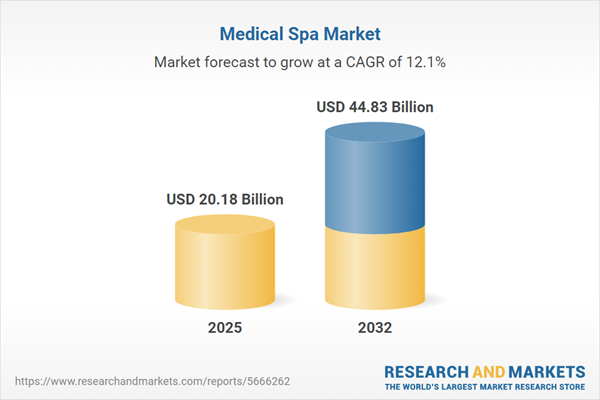Speak directly to the analyst to clarify any post sales queries you may have.
The medical spa market is evolving rapidly as providers integrate medical aesthetics with wellness principles, expand digital capabilities, and restructure services to deliver optimal client experiences. Senior decision-makers are steering innovation by aligning strategies across both regional and operational areas, strengthening organizational expertise, and enhancing outcomes.
Market Snapshot: Medical Spa Market Size & Growth
The global medical spa market achieved USD 18 billion in 2024 and is expected to reach USD 20.18 billion by 2025, with projections of over USD 44.83 billion by 2032. The industry is registering a compound annual growth rate (CAGR) of 12.08%. This expansion is fueled by strong demand for minimally invasive aesthetic procedures and an increased inclination towards bundled offerings that unite preventive wellness with advanced clinical care. Digital transformation strategies continue to reshape business models, driving both portfolio diversification and client engagement. Competitive momentum persists as consumer expectations elevate, prompting providers to refine personal experiences and results to unlock new avenues for growth.
Scope & Segmentation of the Medical Spa Market
- Service Type: Service offerings encompass advanced body contouring procedures such as cryolipolysis and ultrasound cavitation, along with injectables including botulinum toxin and platelet-rich plasma treatments. Laser-based therapies for hair or tattoo removal stand alongside rejuvenation services like microneedling and chemical peels. In addition, wellness services feature hormone optimization, intravenous infusions, and customized nutrition advice to deliver holistic, client-centric solutions.
- End User Demographics: Providers support personalized care pathways designed for both male and female clients, accounting for diverse backgrounds and individual health or aesthetic objectives.
- Distribution Channel: In-person clinical environments remain central, complemented by a growing reliance on virtual consultation platforms that boost convenience and client reach. Collaborations with hospitals enable complex, coordinated care, leveraging interdisciplinary expertise.
- Geographical Coverage: The sector operates globally, with notable activity across the Americas, Europe, Middle East and Africa, and Asia-Pacific. Regional trends reflect differences in regulatory standards, adoption of digital tools, and consumer preferences, requiring flexible local execution within overarching global strategies.
- Leading Companies: Organizations such as Merz Pharma GmbH & Co. KGaA, Galderma S.A., Alma Lasers Ltd., Chic La Vie, Clinique La Prairie, Kurotel Longevity Medical Center, AbbVie Inc., Hologic Inc., Candela Corporation, and Lutronic Corporation define innovation standards and lead cross-market developments.
Key Takeaways for Senior Decision-Makers
- Blending wellness philosophies with medical aesthetics supports deeper, long-term client engagement and heightens retention rates.
- Expansion of digital tools streamlines integration between physical and remote service touchpoints, enhancing brand connectivity and facilitating seamless experiences.
- Maintaining stringent clinical protocols and robust safety measures builds credibility and supports compliance across regulated geographies.
- Diversification through in-clinic services, teleconsultations, and collaborations with hospitals empowers organizations to respond swiftly to evolving client preferences.
- Continuously monitoring market changes and soliciting client insights ensures agile adaptation and maintains business relevance in shifting landscapes.
- Navigating compliance through localized regulatory frameworks safeguards operations and boosts stakeholder trust, particularly within multi-regional rollouts.
Tariff Impact & Supply Chain Resilience
Recent adjustments to tariffs for medical devices and consumables are prompting organizations to revisit procurement practices in the medical spa sector. Strengthening partnerships across a broader range of suppliers and working closely with local distributors are recognized approaches to reinforce inventory flow and minimize potential disruptions. Open and transparent communication with clients around pricing fluctuations helps sustain loyalty and ensures the continued delivery of quality services, even amid market volatility.
Methodology & Data Sources
This analysis is based on input from industry leaders in clinical, procurement, operational, and compliance disciplines. Findings are verified using structured research, regulatory filings, and registration data, providing market intelligence that is actionable and fully supported.
Why This Report Matters
- Enables executive teams to optimize strategies by leveraging comprehensive segment analysis and evolving trends for stronger competitive positioning.
- Supports proactive risk management by offering clarity on regulatory obligations and supply chain dynamics within a changing global environment.
- Helps organizations benchmark their progress in digitalization and integrated care, reinforcing adaptability amid continuous regulatory and market shifts.
Conclusion
Effective leadership within the medical spa industry depends on strategic agility and a sustained focus on client-centered service. Organizations that embrace innovation and adjust promptly to market demands will continue to find new opportunities in an evolving sector.
Additional Product Information:
- Purchase of this report includes 1 year online access with quarterly updates.
- This report can be updated on request. Please contact our Customer Experience team using the Ask a Question widget on our website.
Table of Contents
3. Executive Summary
4. Market Overview
7. Cumulative Impact of Artificial Intelligence 2025
Companies Mentioned
The companies profiled in this Medical Spa market report include:- Merz Pharma GmbH & Co. KGaA
- Galderma S.A.
- Alma Lasers Ltd.
- Chic La Vie
- Clinique La Prairie
- Kurotel Longevity Medical Center
- AbbVie Inc.
- Hologic, Inc.
- Candela Corporation
- Lutronic Corporation
Table Information
| Report Attribute | Details |
|---|---|
| No. of Pages | 192 |
| Published | October 2025 |
| Forecast Period | 2025 - 2032 |
| Estimated Market Value ( USD | $ 20.18 Billion |
| Forecasted Market Value ( USD | $ 44.83 Billion |
| Compound Annual Growth Rate | 12.0% |
| Regions Covered | Global |
| No. of Companies Mentioned | 11 |









